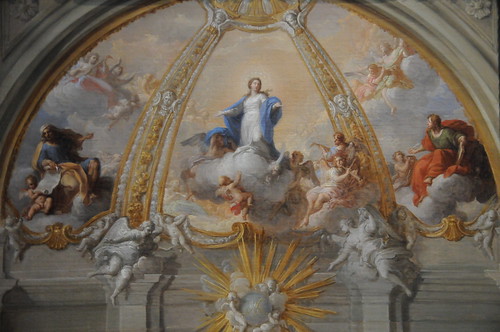,_by_Velazquez.jpg) |
| Velazquez, Las Meninas, 1656 |
The Infanta Margaret Theresa monopolizes the piece, without a doubt. Taking up barely any space in the huge, busy room, she still strikes the viewer and stands proud in the center, gazing directly forward. Other characters look forward as well, like the tall painter and the small girl near the dog, but they are in darker colors and do not command the attention the little girl demands. Almost completely in white, the sunlight illuminates her entire form, from her angelically light hair to the hem of her ridiculous dress. She holds such power in such a tiny container, doted on by every single person in that room from her maids of honor, chaperone, and bodyguard to the two dwarfs and the dog. Reflected in the mirror are her parents, completely separate from the space but watching over her nonetheless.
She immediately reminds me of Claudia from Interview with the Vampire, both adored by those around them and so very proud. Claudia, of course, has darker elements. Forever cursed to be stuck as child, she must live a child-like existence even though she's hundreds of years old. The forced immaturity infuriates her, specifically in this scene. She cuts and cuts her hair, trying to change herself so that she can evolve or just not be the exact same girl she's been for hundreds of years. But it grows back, turning her back again into the one person she does not want to be.
Louis and Lestat, the two vampires who watch over her, do what they can to keep her safe even she is truly powerful and old enough to take care of herself. Her duality comes across painfully, the viewer taking part in her inner conflict as well. I think the thing that truly connects the two with me is how they seem so very small and restrained in their respective worlds, but they are so very important to those around them. There are aspects of the two girls that are far different, of course. One is a little princess, the other is a vampire cursed to eternal childhood. But the restraints on both of them are very similar, both made to look like dolls, porcelain and perfect, and never able to - or allowed to - be independent of their caretakers or their own image. It seems a caged existence, one expertly depicted through both film and paint and crystal clear to viewers of either.
Louis and Lestat, the two vampires who watch over her, do what they can to keep her safe even she is truly powerful and old enough to take care of herself. Her duality comes across painfully, the viewer taking part in her inner conflict as well. I think the thing that truly connects the two with me is how they seem so very small and restrained in their respective worlds, but they are so very important to those around them. There are aspects of the two girls that are far different, of course. One is a little princess, the other is a vampire cursed to eternal childhood. But the restraints on both of them are very similar, both made to look like dolls, porcelain and perfect, and never able to - or allowed to - be independent of their caretakers or their own image. It seems a caged existence, one expertly depicted through both film and paint and crystal clear to viewers of either.





















